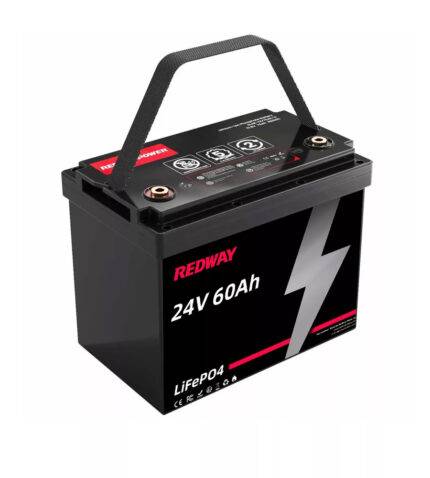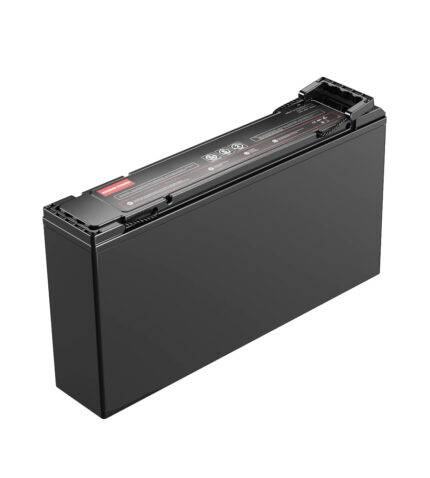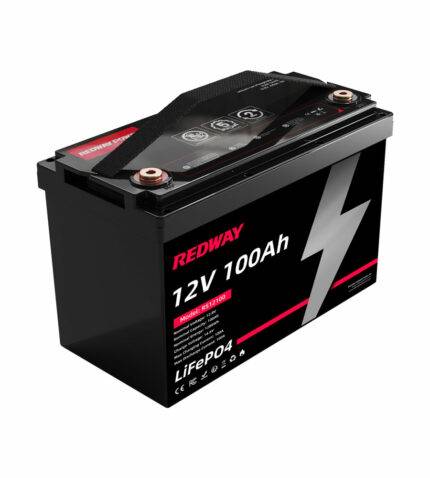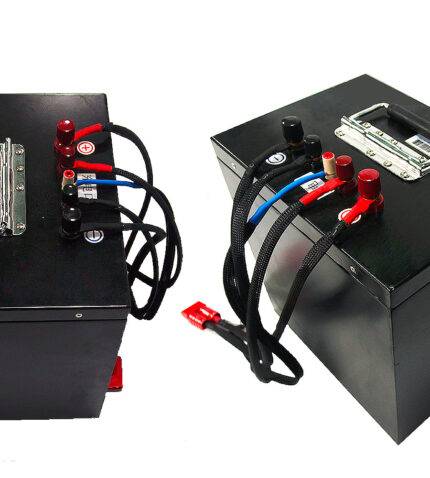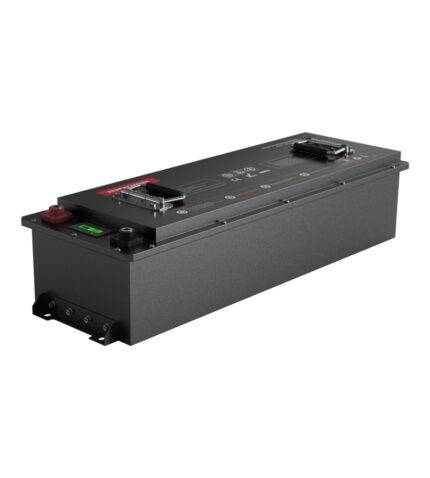| 24V105Ah | Specifications |
|---|---|
| Cell Type | LiFePO4 |
| Nominal Voltage | 25.6V |
| Nominal Capacity | 105Ah |
| Nominal Energy | 2688Wh |
| Charge Voltage | 29.2V |
| Discharge Voltage | 20V |
| Max. Continues Charge Current | 100A |
| Max. Continues Discharge Current | 100A |
| Dimensions [L x W x H] | 522 x 240 x 218 mm 20.5 x 9.4 x 8.6 in |
| Weight | 19 kg 41.9 lb |
| IP Rating | IP65 (More request) |
| Series & Parallel | 8S7P |
| Max. Battery Parallel | 4P to 10.7kWh (More request) |
| Internal Resistance | ≤30mΩ |
| Cycle Life | >4000 cycles (DOD 80%) |
| Self-Discharge | 3% (Per month) |
| Charge Temperature | 0°C ~ 60°C 32°F ~ 140°F |
| Discharge Temperature | -20°C ~ 65°C -4°F ~ 149°F |
| Optional Functions | Bluetooth / WiFi / LCD / LED Touch Screen / RS485 / RS232 / CAN / 4G, 5G / GPS / APP |
| Charger | High current fast charger |
| BMS | Intelligent BMS protection |
| Terminal | M8 Bolts |
| Battery Case | ABS (Fireproof plastic) |
| Warranty | 3 Years |
| Silk-Screen / Label Printing | Yes |
| User Manual / Warranty Card | Yes |
| Customization / OEM / ODM | Yes |
| Shipment | Yes |
| Certifications | IEC, UN38.3, MSDS (More request) |
24V 105Ah Lithium Battery (Standard)
• Cell: LiFePO4
• MOQ: 50
• Delivery: 20 Days
• Customizable / OEM / ODM: Yes
• Factory: Redway, Dongguan, Guangdong, China
• Delivery Terms: FOB, EXW, CIF
• Payment: T/T, L/C, PayPal
• Sea / Air / Land Shipment: 10FT, 20FT, 40FT, 60FT
Category: 24V Lithium Battery
Tags: 24V, 24V 100Ah, LFP, LiFePO4 Battery, Lithium Battery, Marine Boat Battery, RV Battery, RV LiFePO4
Description
Specifications
Download 24V 105Ah (Standard) Datasheet
Note: Our products are customizable, allowing customers to modify the main data according to their requirements.
| 24V105Ah | Specifications |
|---|---|
| Cell Type | LiFePO4 |
| Nominal Voltage | 25.6V |
| Nominal Capacity | 105Ah |
| Nominal Energy | 2688Wh |
| Charge Voltage | 29.2V |
| Discharge Voltage | 20V |
| Max. Continues Charge Current | 100A |
| Max. Continues Discharge Current | 100A |
| Dimensions [L x W x H] | 522 x 240 x 218 mm 20.5 x 9.4 x 8.6 in |
| Weight | 19 kg 41.9 lb |
| IP Rating | IP65 (More request) |
| Series & Parallel | 8S7P |
| Max. Battery Parallel | 4P to 10.7kWh (More request) |
| Internal Resistance | ≤30mΩ |
| Cycle Life | >4000 cycles (DOD 80%) |
| Self-Discharge | 3% (Per month) |
| Charge Temperature | 0°C ~ 60°C 32°F ~ 140°F |
| Discharge Temperature | -20°C ~ 65°C -4°F ~ 149°F |
| Optional Functions | Bluetooth / WiFi / LCD / LED Touch Screen / RS485 / RS232 / CAN / 4G, 5G / GPS / APP |
| Charger | High current fast charger |
| BMS | Intelligent BMS protection |
| Terminal | M8 Bolts |
| Battery Case | ABS (Fireproof plastic) |
| Warranty | 3 Years |
| Silk-Screen / Label Printing | Yes |
| User Manual / Warranty Card | Yes |
| Customization / OEM / ODM | Yes |
| Shipment | Yes |
| Certifications | IEC, UN38.3, MSDS (More request) |
Applications and FAQs
24V 105Ah (Standard) LiFePO4 batteries outperform traditional deep cycle batteries, lasting up to 4000 cycles compared to SLA batteries' 500 cycles. This longevity ensures a lower cost per use. Their popularity stems from reliability in home alarm systems, camping, and solar lighting applications, offering enhanced durability and cost-effectiveness, making them a top choice in today's market.
What is a 24V 105Ah (Standard) lithium battery?
A 24V 105Ah lithium-ion battery is a robust energy storage solution designed for diverse applications that demand reliable and long-lasting power. It outperforms traditional lead-acid batteries like AGM or GEL with its lightweight construction and exceptional performance, particularly excelling in deep cycle applications. Widely used across industries, these batteries are integral in off-grid or self-sustaining setups, often integrated with solar systems for storing surplus energy. Additionally, they serve as reliable backup power sources in UPS units.
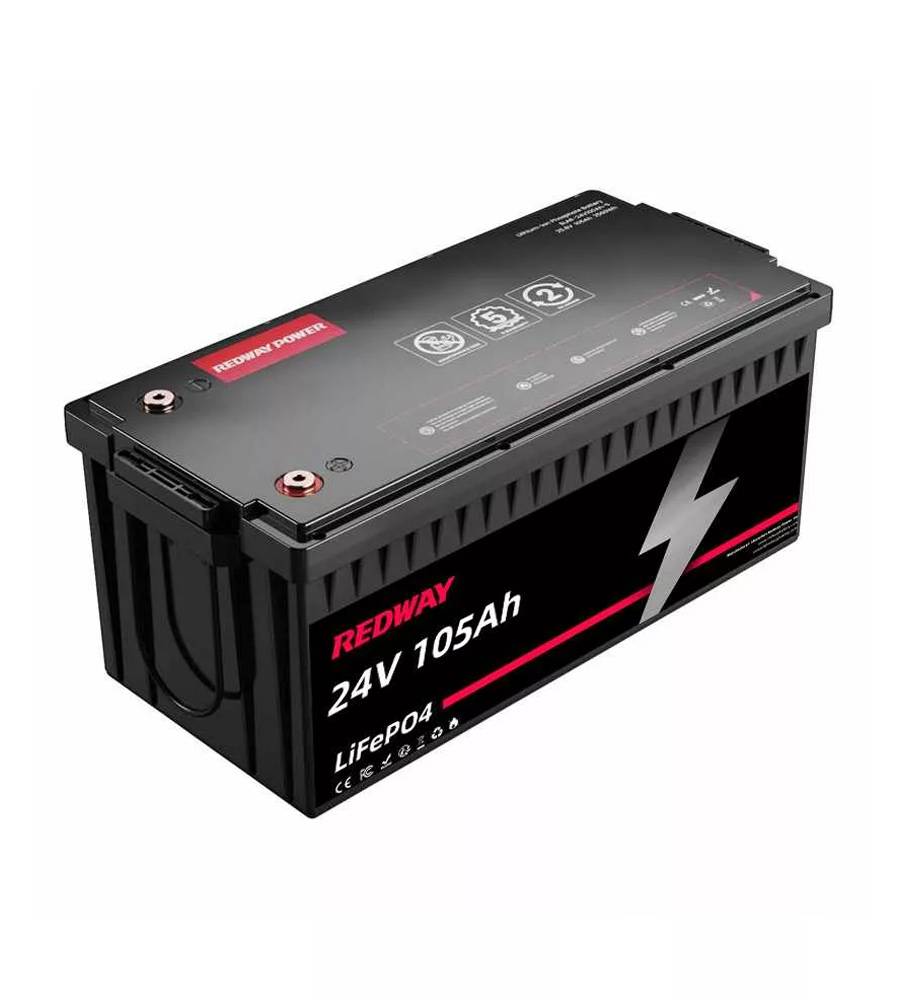
With a continuous current output of 5 Amperes sustained over 21 hours, totaling 105Ah capacity, these batteries offer substantial energy storage of 2,520 Watt-hours or 2.52kWh at 24 volts. Overall, they provide a versatile and dependable power solution, making them ideal for industrial, commercial, and residential applications requiring reliable energy storage.
Note: we have 3 versions of 24V 105Ah lithium-ion batteries: Standard, Thinner, Much Thinner.
Where can you use a 24V 105Ah battery?
A 24V 105Ah lithium battery can be used in various applications across different industries, thanks to its versatile and reliable power capabilities. Some common uses include:
- Off-grid Solar Systems: These batteries are ideal for storing excess solar energy generated during the day for use during the night or when sunlight is not available.
- Backup Power Systems: 24V 105Ah lithium batteries are commonly used in backup power systems, such as UPS units, ensuring uninterrupted power supply during outages.
- Electric Vehicles: They are suitable for use in electric vehicles, providing the necessary power for propulsion and other onboard systems.
- Marine and RV Applications: These batteries can power various systems onboard boats, yachts, and recreational vehicles, offering reliable and long-lasting energy storage.
- Remote Monitoring Stations: Due to their reliability and long cycle life, 24V 105Ah lithium batteries are used in remote monitoring stations where continuous power is essential.
- Industrial Equipment: They are used to power various industrial equipment requiring a reliable and long-lasting power source.
- Emergency Lighting Systems: These batteries can be used in emergency lighting systems to ensure that they remain operational during power outages.
Overall, the 24V 105Ah lithium battery is a versatile power solution suitable for a wide range of applications where reliable energy storage is essential.
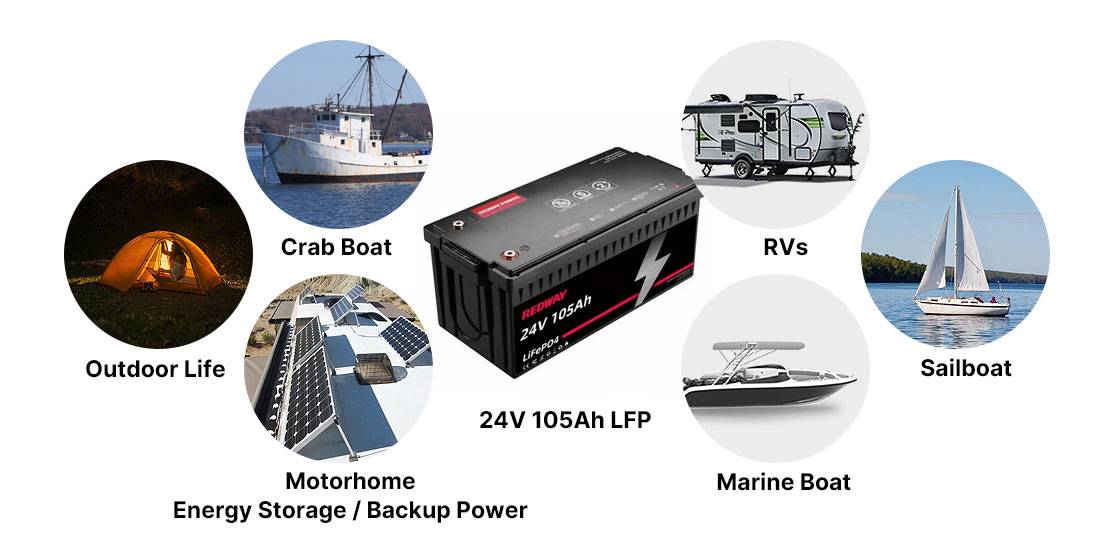
Explain the different advantages of a 24V 105Ah lithium-ion battery?
A 24V 105Ah lithium-ion battery presents a multitude of advantages over traditional lead-acid batteries, making it a preferred choice for various applications. These benefits encompass:
- Connectable in Parallel and Series:Harness the versatility of a 24V 105Ah lithium battery by connecting multiple units in both parallel and series configurations. This allows for scalability and customization of power systems to meet specific energy requirements.
- No Memory Effect:Enjoy the convenience of charging and using the battery at any time without the need for discharging beforehand. The absence of a memory effect ensures optimal performance and extended device operation on a single charge.
- Good Cycle Life:Benefit from a robust cycle life, providing reliable power output over an extended period. With higher amp-hours and fast-charging capabilities, the battery delivers consistent performance, promising up to 5000 cycles with a five-year warranty, contingent upon usage frequency.
- Higher Energy Density:Experience enhanced power delivery in a lightweight and compact package. The heightened energy density of lithium-ion batteries enables high current output and increased power storage capacity, ideal for applications where space and weight constraints are paramount.
- Low Self Discharge:Appreciate minimal energy loss during storage periods, thanks to the low self-discharge rate inherent to lithium-ion batteries. Unlike traditional counterparts, a 24V 105Ah lithium battery retains stored energy efficiently, ensuring readiness for use when needed.
- Eco-Friendly:Embrace sustainability and environmental consciousness with lithium-ion technology. These batteries are non-toxic, acid-free, and safe to use, contributing to a cleaner and greener energy ecosystem. By utilizing renewable energy sources for power generation and minimizing noise pollution, lithium-ion batteries exemplify eco-friendly energy storage solutions.
In addition to versatility in connectivity and freedom from memory effect, 24V 105Ah lithium-ion batteries have robust cycle lives, enhanced energy density, low self-discharge, and eco-friendliness, making them an ideal choice for a variety of applications.
What are the disadvantages of a 24V 105Ah lithium battery?
Despite their numerous advantages, 24V 105Ah lithium batteries also have some drawbacks.
- Higher Initial Cost: One significant drawback is the higher initial cost compared to lead-acid batteries. This expense may deter some users, especially those on tight budgets.
- Potential Degradation: Lithium-ion batteries can degrade if exposed to extreme temperatures or overcharged. Proper management and monitoring systems are necessary to prevent degradation and ensure longevity.
- Safety Concerns: There are safety concerns regarding thermal runaway and fire risk if the battery is damaged or mistreated. Appropriate handling and safety precautions are essential to mitigate these risks and ensure safe operation.
How long will a 24V 105Ah battery last if fully charged?
The amount of time a fully charged 24V 105Ah battery will last depends on both the load it supports and its discharge rate. To determine the runtime, simply divide the battery's capacity (measured in ampere-hours) by the current draw of the load (measured in amperes). For instance, if the load draws 10 amps, the battery should last approximately 50 hours (105Ah ÷ 10A = 10.5 hours) under optimal conditions. However, external factors such as temperature, age, and depth of discharge can impact the actual runtime, so it's important to take these variables into account when estimating battery lifespan.
How is a deep cycle 24V 105Ah lithium battery better than a deep cycle lead-acid battery?
A deep cycle 24V 105Ah lithium battery surpasses a deep cycle lead-acid battery in several aspects.
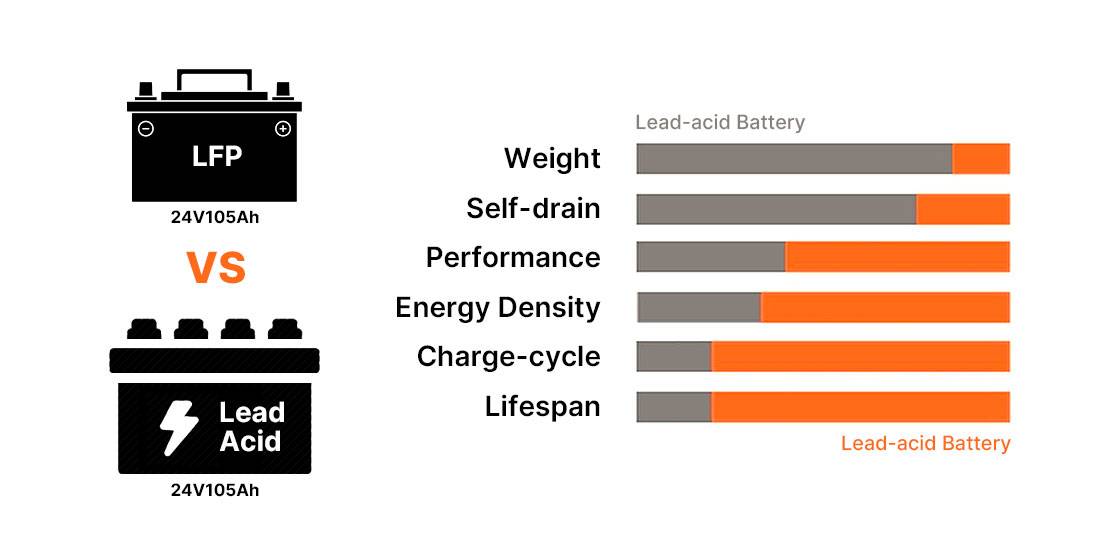
- Lighter and Samller: For the same energy capacity, lithium batteries are lighter and occupy less space than lead-acid batteries.
- Higher Energy Density:Lithium batteries have a higher energy density, allowing them to store more energy in the same space. This results in a more compact and lightweight design compared to lead-acid batteries.
- Longer Cycle Life:Lithium batteries offer a longer cycle life. Despite being expensive, lithium batteries offer 80-90% Depth of Discharge (DOD) and up to 4000 cycles, whereas lead-acid batteries offer 50% DOD and a maximum of 500 Therefore, lithium batteries are durable, safe to use, and have a longer lifespan.
- Efficient Charging:Lithium batteries charge more efficiently than lead-acid batteries. They also have a lower self-discharge rate, ensuring stored energy is retained for longer periods without significant loss.
- Maintenance-Free Operation:Lithium batteries are maintenance-free compared to lead-acid batteries. This reduces overall operational costs and hassle associated with maintenance tasks, making lithium batteries a more convenient option for users.
What quality standards should a 24V 105Ah lithium battery fulfill during its manufacturing?
- Adherence to International Standards:Ensure compliance with international regulations such as ISO 9001 for quality management systems and ISO 14001 for environmental management systems during manufacturing.
- Certifications for Safety and Compliance:Obtain certifications like UL (Underwriters Laboratories) or CE (Conformité Européenne) to demonstrate compliance with safety and product standards in specific regions.
- Rigorous Testing Procedures:Subject the battery to rigorous testing procedures, including the IEC 62133 test, to verify safety and prevent short-circuiting during transportation and use.
- Stringent Manufacturing Processes:Implement stringent manufacturing processes to maintain consistency and quality throughout the production of the battery.
- Comprehensive Quality Control Measures:Implement comprehensive quality control measures to monitor and ensure the quality and performance of the battery at every stage of production.
Adhering to these points ensures that the 24V 105Ah lithium battery meets industry and regulatory requirements, guaranteeing reliable performance and safety for users.

Is it safer to use a 24V 105Ah lithium-ion battery in small size vehicles?
Yes, using a 24V 105Ah lithium-ion battery in small-sized vehicles can offer enhanced safety compared to traditional lead-acid batteries. Lithium-ion batteries are inherently safer due to their stable chemistry and reduced risk of leakage or spillage, making them suitable for compact vehicle installations where space is limited. Additionally, lithium batteries have built-in protection circuits to prevent overcharging, over-discharging, and short circuits, mitigating potential safety hazards. However, proper installation, handling, and maintenance are essential to maximize safety and prevent accidents, regardless of the battery type used.
What are the features of a 24V 105Ah lithium-ion battery?
The 24V 105Ah lithium-ion battery stands out for its desirable characteristics, making it a top pick for many uses. Its high energy density means it can store more energy in a compact and lightweight form compared to traditional lead-acid batteries. It also boasts a lengthy cycle life, enduring multiple charge and discharge cycles without significant capacity loss, ensuring consistent performance over time. Moreover, charging is more efficient, self-discharge is lower, and maintenance is minimal with lithium-ion batteries, providing a cost-effective and hassle-free power solution.
What are the specifications of a 24V 105Ah lithium-ion battery?
The details of a 24V 105Ah lithium-ion battery typically consist of its voltage rating of 12 volts and a capacity of 105 ampere-hours (Ah). Other significant specifications may encompass size, weight, maximum discharge current, operating temperature range, expected cycle life, and safety attributes like built-in protection circuits. As these specifications can differ based on the manufacturer and intended purpose, it is vital to review the datasheet or product specifications to guarantee compatibility and peak performance in specific scenarios.
How to maintain a 24V 105Ah lithium-ion battery?
Maintaining a 24V 105Ah lithium-ion battery is crucial for maximizing its lifespan and ensuring optimal performance. Here's how to effectively maintain your lithium battery:
- Follow Manufacturer Guidelines:Adhere to all guidelines provided by the manufacturer before using the battery, and handle it with care to prevent damage.
- Regular Monitoring:Avoid leaving the lithium battery unattended for extended periods. Regularly check the battery status and charge rate, as it may gradually self-discharge when not in use.
- Charge Before Storage:Although lithium batteries have a low self-discharge rate, it's essential to charge or discharge them before extended storage periods. Avoid storing them at high temperatures, as this can reduce their lifespan.
- Handle with Precaution:Take precautions to protect the battery from excessive vibrations, as they can affect its performance. Additionally, manage temperature and prevent overcharging (high-voltage) to maintain optimal battery health.
By following these maintenance practices, you can ensure that your 24V 105Ah lithium-ion battery remains in excellent condition, providing reliable power when needed.


